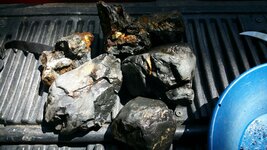oregonmp03
Full Member
So I've poked around two separate creeks on a river that's nearby. The first creek is just a trickle of a creek but has a lode mine above it. I haven't had a chance to pan it because of lack of water but I detected it today and found 4 solid black rocks with rust/iron looking deposits on them. My detector and pinpointer picked them up. They are not hotrocks, they just give out a really strong signal and certain parts of the rock hit harder with the pinpointer than others. They produce no gold when ground down.
The other creek is right next door and while walking through the forest with my detector on to get to the creek boom, I get the same type of hit. Dig down 1 inch and find the same type of rock, just rougher. No idea what it is solid hit, not a hotrock, my detector overloads when it's a hotrock.
I go sluice in the creek and don't get a single thing. But the walls to the creek are just loaded with rust and my detector hits on them hard, even with iron completely masked out. This is the second trip to the creek with no luck in the sluice but I always grab a couple samples on my way out and both times I've been there I've grabbed quartz pieces that when crushed down produced a piece or two of gold.
I'm just at a loss of what to think/do with the area. Detecting only hits on those black rust stained rocks, in both creeks. No gold in the sluice, but gold in the quartz rocks every time it's crushed.. I've posted a picture of the rocks that I'm getting hits on with my detector. I'm just not sure if I should focus on sluicing and hitting bedrock or concentrate on the quartz or what. Not even sure what the black rocks are.

The other creek is right next door and while walking through the forest with my detector on to get to the creek boom, I get the same type of hit. Dig down 1 inch and find the same type of rock, just rougher. No idea what it is solid hit, not a hotrock, my detector overloads when it's a hotrock.
I go sluice in the creek and don't get a single thing. But the walls to the creek are just loaded with rust and my detector hits on them hard, even with iron completely masked out. This is the second trip to the creek with no luck in the sluice but I always grab a couple samples on my way out and both times I've been there I've grabbed quartz pieces that when crushed down produced a piece or two of gold.
I'm just at a loss of what to think/do with the area. Detecting only hits on those black rust stained rocks, in both creeks. No gold in the sluice, but gold in the quartz rocks every time it's crushed.. I've posted a picture of the rocks that I'm getting hits on with my detector. I'm just not sure if I should focus on sluicing and hitting bedrock or concentrate on the quartz or what. Not even sure what the black rocks are.

Upvote
0







